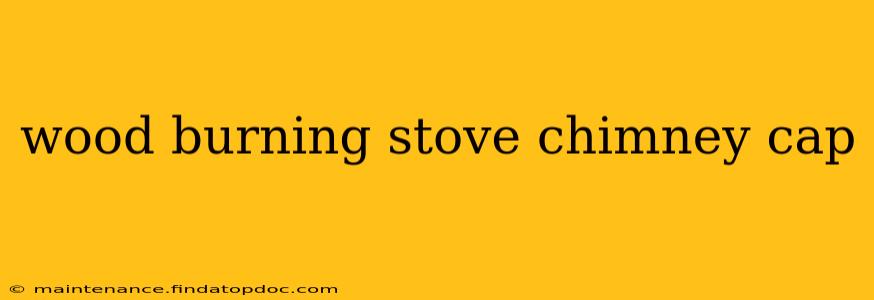A chimney cap is a crucial component of any wood-burning stove system. It protects your chimney from the elements, improves draft, and enhances safety. This comprehensive guide will explore everything you need to know about choosing and installing the right chimney cap for your wood-burning stove. We'll delve into the various types, benefits, and considerations to help you make an informed decision.
What is the Purpose of a Chimney Cap?
A chimney cap serves several vital functions:
-
Protection from the elements: Rain, snow, and debris can damage your chimney and clog the flue, leading to inefficient burning, creosote buildup, and even chimney fires. A cap acts as a shield, preventing water ingress and keeping out leaves, birds' nests, and other obstructions.
-
Improved draft: A well-designed chimney cap can improve the airflow within your chimney, ensuring a more efficient and safer burn. This is particularly important in windy conditions where downdrafts can impede the exhaust process.
-
Enhanced safety: By preventing debris and animals from entering your chimney, a cap minimizes the risk of chimney fires and structural damage.
-
Increased longevity: Protecting your chimney from the elements significantly extends its lifespan, saving you on costly repairs or replacements in the long run.
What are the Different Types of Chimney Caps?
Several types of chimney caps are available, each with its own advantages and disadvantages:
-
Standard Chimney Caps: These are the most common type, typically made from stainless steel or galvanized steel. They offer good protection from the elements and are relatively inexpensive.
-
Rain Caps: These caps are designed to primarily deflect rainwater, often with a wider brim than standard caps. They are a good choice for areas with significant rainfall.
-
Spark Arrestors: These caps include a mesh screen that prevents sparks and embers from escaping the chimney, reducing the risk of wildfires. They are essential in areas with dry vegetation or fire restrictions.
-
Animal Guards: These caps feature a mesh or other barrier to prevent animals such as birds, squirrels, and raccoons from nesting in your chimney.
-
Adjustable Chimney Caps: These allow for customization to fit various chimney sizes and shapes.
How Do I Choose the Right Chimney Cap for My Wood Burning Stove?
Choosing the right chimney cap depends on several factors:
-
Chimney size and shape: Measure your chimney's diameter and ensure the cap you choose is the appropriate size. Consider the shape of your chimney top as well, selecting a cap that fits snugly.
-
Climate: In areas with heavy rainfall or snowfall, a rain cap or a cap with a wider brim might be preferable. In fire-prone regions, a spark arrestor is essential.
-
Material: Stainless steel is a popular choice due to its durability and resistance to corrosion. Galvanized steel is a more affordable option, but it may rust over time.
How Do I Install a Chimney Cap?
Installing a chimney cap is a relatively straightforward process, but safety should always be your top priority. If you are uncomfortable working at heights, it's best to hire a professional chimney sweep or contractor. Always ensure your chimney is clean and free from obstructions before installation. The specific installation method will vary depending on the type of cap and your chimney's design. Generally, it involves securing the cap to the chimney using screws or other fasteners.
What are the Benefits of Using a Chimney Cap?
The benefits of using a chimney cap are numerous and significant:
-
Extended chimney lifespan: Protection from the elements translates directly into a longer-lasting chimney.
-
Improved efficiency: Better draft leads to more efficient burning and reduced fuel consumption.
-
Enhanced safety: Prevention of fires and structural damage is paramount.
-
Reduced maintenance: Less debris buildup means less frequent cleaning is needed.
How Often Should I Inspect My Chimney Cap?
Regular inspection is crucial for ensuring your chimney cap remains functional and effective. Inspect your cap at least once a year, ideally before the start of the heating season, checking for any damage, rust, or obstructions.
What Happens if I Don't Use a Chimney Cap?
Without a chimney cap, your chimney is vulnerable to damage from the elements, leading to potential hazards such as:
-
Water damage: Rainwater can seep into the masonry, causing deterioration and structural weakness.
-
Blockages: Debris can clog the flue, reducing draft and increasing the risk of creosote buildup and chimney fires.
-
Animal infestations: Birds, squirrels, and other animals can build nests in your chimney, creating fire hazards and damaging the structure.
In conclusion, investing in a high-quality chimney cap is a wise decision for any homeowner with a wood-burning stove. The benefits far outweigh the cost, providing peace of mind, enhanced safety, and a longer lifespan for your chimney. Remember to choose a cap appropriate for your specific needs and always prioritize safety during installation and maintenance.
